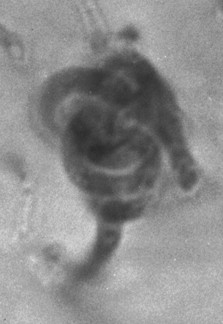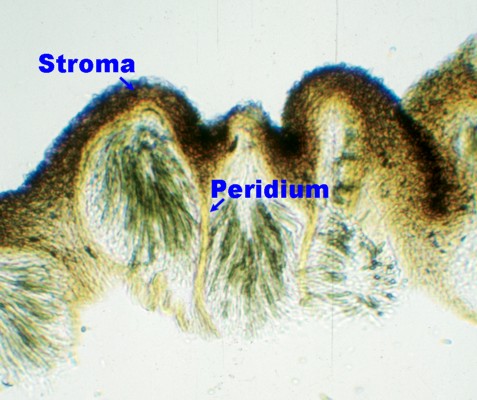DISCUSSION OF THE SORDARIOMYCETES
The class Sordariomycetes encompasses the Ascomycota having unitunicate asci borne in perithecia. The only exception to this generalization is found in certain groups where the perithecium lacks an ostiole, and forcible ascospore discharge has been lost. These exceptions are explored further in the Plectomycete pages.

In common with other unitunicate Ascomycota, members of the Sordariomycetes produce perithecia that are initiated by coiled or variously distinctive structures containing the ascogonium. The ascogonium is the cell that will receive a nucleus during mating then and go on to produce the dikaryotic hyphal system. Read the Discussion of the Dikarya for a review of this process. The picture at left illustrates the ascogonial coil of Hapsidospora irregularis, a member of the subclass Hypocreomycetidae. One of the cells within the coil functions as the ascogonium and the rest either remain inactive or give rise to hyphae that branch and proliferate to surround the entire structure. In many cases neighbouring hyphae also come to envelope the coil. These surrounding hyphae eventually consolidate to form the walls or peridium of the perithecium. Thus members of the Sordariomycetes nearly always have perithecia (or cleistothecia) with distinct walls that are easily distinguished from other tissues. The development of a perithecial wall from hyphae surrounding the ascogonial initials is a distinctive feature of the Sordariomycetes and one that distinguishes it from the Dothideomycetes.

The above discussion would appear to be a little beyond the scope of these pages were it not for the fact that many Sordariomycetes produce their perithecia in a stroma (plural: stromata) and come to resemble members of the Dothideomycetes quite closely. A stroma is simply a fungal tissue composed of compacted and often thickened and highly pigmented hyphae that may become extensive enough to dominate the appearance of the organism. A stroma produced by the Sordariomycetes may strongly resemble one produced by the Dothideomycetes. However, if the stroma contains perithecial cavities as it commonly does in both classes the two will still be distinguishable because "true" perithecial walls will be present in the Sordariomycetes and absent in the Dothideomycetes. Usually the perithecia of the Sordariomycetes can be popped out of the stroma, walls and all, something that cannot be done with the Dothideomycetes, which lack separate walls. In the picture at right a crude razor-blade section of a Hypocrea species shows three perithecia embedded within a common reddish brown stroma, with the yellow peridium of each perithecium clearly visible and separate.
The Sordariomycetes can be divided into three subclasses: the Sordariomycetidae, the Hypocreomycetidae and the Xylariomycetidae. Although these three subclasses are now supported by genetic evidence they are hardly different from traditional schemes. Although a precise definition of each subclass based on appearance is difficult we can assign most species to their appropriate places without difficulty.
Sordariomycetidae - most members of this subclass have darkly-coloured perithecia. Most have asci with distinct apical rings or pores. Many species have dark brown to black ascospores but this is certainly not a universal characteristic. Anamorphs (asexual reproductive structures) are highly developed in some of the plant-associated species but may otherwise be inconspicuous. Look here particularly for darkly-coloured species occurring on living or recently dead plants and for species on dung.
Hypocreomycetidae - many members of this group have brightly-coloured perithecia, stromata and anamorphs. Ascospores are almost never brown although they can be copper-coloured in the Microascales. Asci tend to lack apical rings and pores, although these can be present in members of the Clavicipitaceae. Anamorphs are often phialidic (eg. Acremonium, Fusarium, Trichoderma). Many species are parasitic on plants, insects and other fungi. If your collection has brightly-coloured perithecia or stromata look for it here.
Xylariomycetidae - darkly-coloured perithecia and stromata are common to most members. Asci may have prominent and elaborate apical structures. Ascospores are often dark and with pores or slits through which they germinate. Stromata can be massive but are lacking in some. Paraphyses (sterile filaments among the asci) may be numerous and conspicuous. Some are parasitic on plants but most seem to be found on dead wood and other plant parts. If you have a fungus with dark spores and massive stromata it probably goes in this subclass.